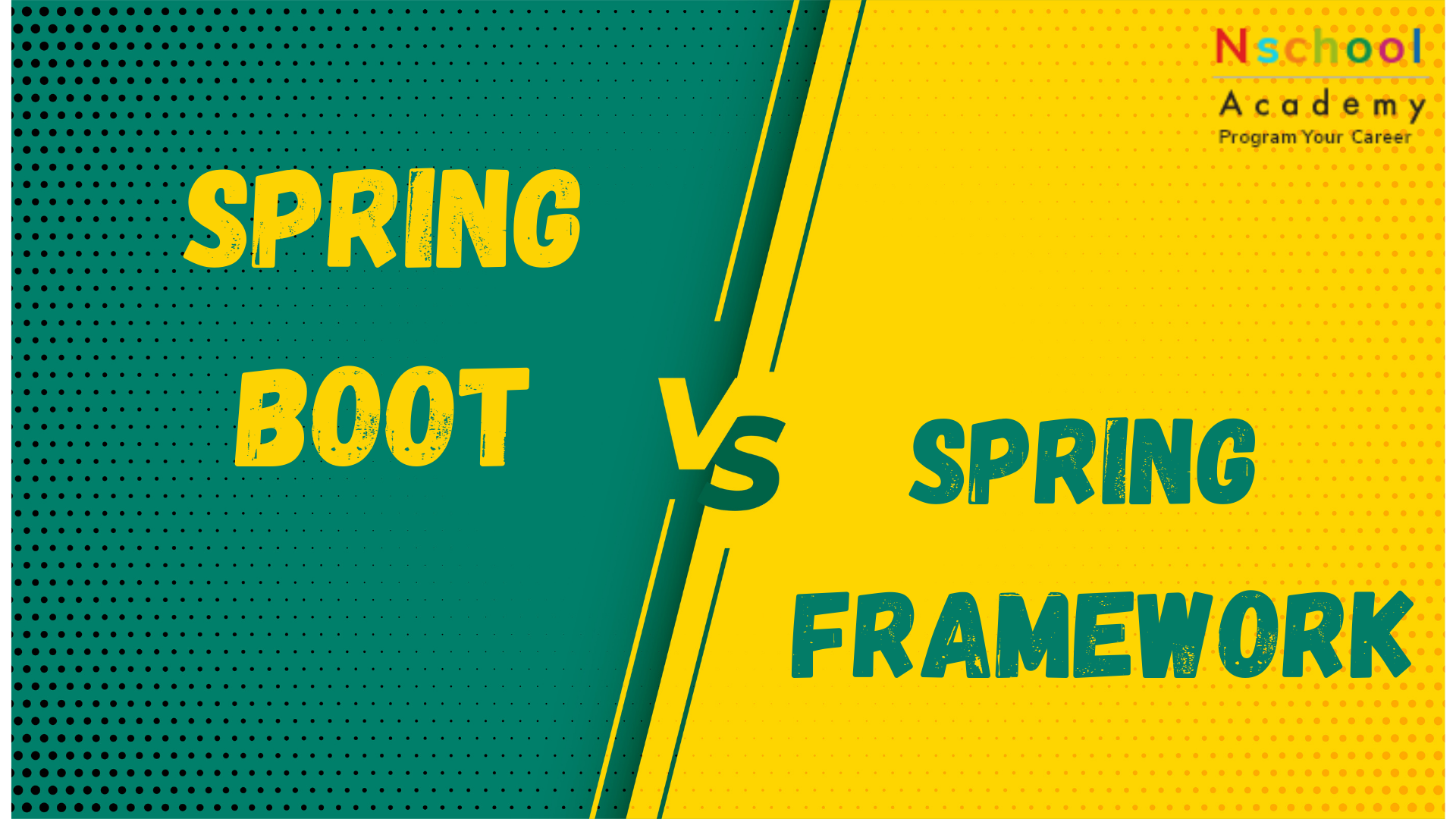Spring Boot vs. Spring Framework
- August 24, 2024
- nschool
- 0

Spring Boot vs. Spring Framework: Key Differences and When to Use Each
Java development is a field where tools like the Spring Framework and Spring Boot play a vital role in shaping enterprise applications significantly. Both tools belong to the Spring ecosystem. Have their distinct purposes and functionalities. It is essential to have an understanding of the disparities between Spring Boot and Spring Framework to make well-informed choices in software development projects. This detailed guide delves into the nuances of when and how to utilize Spring Boot, versus Spring Framework in your projects.
Introduction
The Spring environment has always been essential in Java development by providing tools and frameworks to make application development and management easier. In the center of this ecosystem lies the Spring Framework – an extensive framework that has developed over time. Spring Boot was later introduced to simplify and streamline the development process for building standalone applications ready for production.
An Overview of the Spring Framework
The Spring Framework made its debut in 2003. Serves as a complete programming and configuration framework, for contemporary enterprise applications built on Java technology.
Dependency injection (DI) simplifies how application components are managed by enabling the injection of dependencies being hard coded into the system.
Aspect Oriented Programming (known as AOP) helps in segregating aspects of a program that cut across multiple modules or layers of an application system. For example, handling logging and managing transactions.
Transaction Management involves providing an approach to handling transactions involving various types of transactional resources.
MVC Framework Offers unique model-view-controller (MVC) structure for constructing Web applications.
Data Access JDBC, JPA and Hibernate are integrated in Data Access.
This flexibility of Spring Framework makes it highly suitable to be used across a wide range of applications from simple web applications to enterprise-level applications.
Spring Boot Overview
Spring Boot, released in 2014, is an extension of the Spring Framework that offers a full stack for the brave new world of microservices. Its primary goals are:
Simplification: Eliminates many dependencies and the necessity of intricate setup and simplistic initial code.
Convention Over Configuration: Adopts well-written defaults as well as auto-configuration for enhanced development.
Standalone Applications: This enables the coding of applications that can independently be run with little to no additional configurations.
Production-Ready: These are features that facilitate the deployment of production, including metrics, health checks, and externalization of configurations.
Spring Boot vs Spring Framework
1. Configuration and Setup
Spring Framework:
Manual Configuration: Involve setting up of beans and components through XML or Java-based configuration to a high degree.
Complex Setup: The configuration in the Spring application also includes configuring the data sources, the transaction managers, and the views resolvers.
Spring Boot:
Auto-Configuration: Spring Tool Suite is an integrated development environment that sets up the Spring application components as per the existing dependencies in the classpath.
Simplified Setup: As a way of basic dependency injection it supplies a list of starting dependencies and a set of parameter defaults which makes additional fine-tuning of the dependencies systematic.
2. Application Structure
Spring Framework:
Flexible Structure: It does not impose an organization of the project in some particular parts or structure of a directory tree. The developers have many more opportunities to influence the process, yet they are the ones who bear most of the risks.
Requires More Setup: Every aspect of the application as well as any other components of the solution like application servers, databases, or messaging systems need special setup by the developers.
Spring Boot:
Convention Over Configuration: Requires a common project layout and structure so that it is simpler to set up projects in the future.
Embedded Servers: Supports embedded servers like Tomcat, jetty, and Undertow for applications that can be run as jar files and no longer need an external application server.
3. Dependencies and Libraries
Spring Framework:
Dependency Management: Developers are left to deal with dependencies and their variations themselves which at times may cause version wars and compatibility problems.
Library Integration: To use extra libraries and frameworks, this control requires clear configuration and setup.
Spring Boot:
Starter POMs: Offers vanilla POMs (Project Object Models) that contain initial dependencies and libraries to ease the reliability problem.
Dependency Management: This involves managing dependency versions and ensuring compatibility through the use of Spring Boot’s dependency management system.
4. Development Speed and Ease
Spring Framework
More Boilerplate Code: Takes more boilerplate code and configuration and is slower to develop and more prone to errors with the boilerplate code.
Manual Configuration: This is perhaps the most tedious procedure as it entails the use of a number of apparatus that has to be set up by hand.
Spring Boot:
Rapid Development: Cuts development time with auto-configuration and starter dependencies allowing developers to code most of the business logic.
Minimal Boilerplate: Cut down the quantity of code that is repetitive and enhances the percentage of the code that will require frequent updates.
5. Deployment and Packaging
Spring Framework:
WAR Files: Usually it is packaged up into WAR – Web Application Archive – and deployed to an external application server.
Manual Deployment: Cannot be automatically deployed and configured with application servers and deployed runtime environments.
Spring Boot:
Executable JARs: Deploys as all-inclusive executable JAR files with included WebLogic servers, decreasing the requirement for other application servers.
Built-In Features: Integrated solutions for measuring, testing the availability of progress and superimposing the application configuration to adapt to the production environment.
6. Monitoring and Management
Spring Framework:
Third-Party Tools: Has to be integrated with other monitoring and management tools in order to use features such as application health check or metrics.
Custom Solutions: In many cases, the application health can be checked and controlled only with the help of custom-developed solutions.
Spring Boot:
Actuator: Features Spring Boot Actuator which comes with built-in endpoints used to monitor overall health, metrics, and environment of application.
Production-Ready Features: Offers common application enhancements such as health checks, metrics, and outside-in configurations and so on, to ease out application programs’ management in their production environment.
When to Use Spring Boot
Spring Boot is an excellent choice for new projects that require fast development, and for existing applications where you need fast and easy deployment with minimal fuss.
Rapid Development: If you want to create an AML solution that can be used to build, train, and deploy a standalone application in a short period.
Microservices Architecture: In cases where building microservices that are light, independent, and accompanied by their web servers.
Standardization: When you have to use a line of code to conform to a specific structure and want conventions to save the configuration costs.
Production-Ready Features: When you require the framework to natively support production features such as health checks, metrics, and externalized configurations.
When to Use Spring Framework
Existing Spring Applications: In situations where developers start with a new Spring application that has already been set with the classical Spring configurations.
Custom Configurations: If you require explicit management of the configuration settings or you want to use initializer configurations not provided by Spring Boot.
Enterprise Systems: When implementing enterprise applications that require the flexibility of Spring Framework to accommodate large and complex applications.
Integration with Existing Infrastructure: In cases where we are extending our applications to existing infrastructure or application servers that define WAR deployments traditionally.
Conclusion
Spring Boot and Spring Framework each offer distinct advantages and are suited to different scenarios. Spring Boot simplifies development and deployment with its auto-configuration, embedded servers, and production-ready features, making it ideal for rapid development and microservices architectures. The Spring Framework, with its comprehensive and flexible approach, continues to be valuable for complex enterprise systems and applications that require custom configurations.
Understanding the key differences between Spring Boot and Spring Framework helps you choose the right tool for your project, ensuring you leverage the strengths of each framework effectively. By aligning your choice with your development needs and goals, you can enhance productivity, maintainability, and overall application quality.

